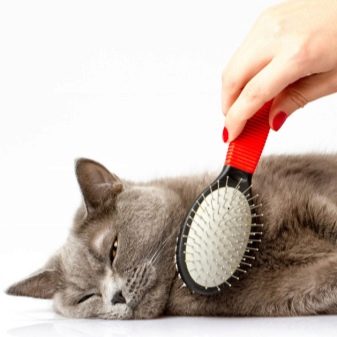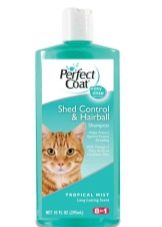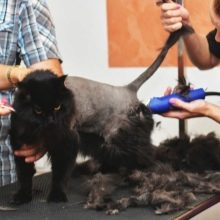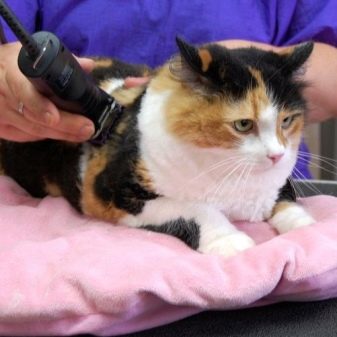Grooming cats: features of the procedure

Animal care professionals know what grooming is. Recently, however, this term has become vague, or even completely incomprehensible. Someone, for example, thinks that this is what they call the grooming of pets. Let's look at the nuances of the term, the features of the procedure, and find out who needs it, as well as how it affects the behavior of the animal.
What it is?
Grooming cats is a complex of caring hygiene procedures. It includes not only a haircut, but also care for the pet's coat, ears, eyes, skin and teeth. This is not at all a whim of the breeder, but rather a necessity to maintain the excellent health of the pet. In addition to cleaning your ears, teeth, eyes and grooming your hair, it includes clipping your nails. A specialist or the owner himself can carry out a set of measures for caring for a cat, if he has the skills and necessary adaptations.

Varieties
Cat grooming can be classified into two types: hygiene and show grooming. The first type of care is aimed at ensuring and maintaining the cleanliness and health of the cat, giving the pet a well-groomed appearance. The caring complex includes 7 different procedures:
- combing pet hair;
- swimming in warm water;
- shearing wool;
- cleaning the ears;
- trimming long claws;
- rinsing the eyes;
- brushing your teeth.


Show grooming differs from ordinary grooming in that it is designed to bring a domestic cat to a certain standard established for a given breed. A professional groomer is engaged in its conduct, paying more attention to the fur of the animal. This type of grooming is necessary mainly for cats that take part in exhibitions.
In this case, the master performs a haircut in such a way that the cat gets a minimum of discomfort.


Necessary accessories
For a complex of procedures use:
- special combs;
- shampoo for cats and cats;
- nail clippers or claw scissors;
- cotton pads or napkins;
- ear cleaners;
- scissors or hair clipper.
In addition, hydrogen peroxide and cotton wool should be on the desktop just in case. If the cat's coat is long, combs with sparse teeth, massage brushes, and gloves to remove fallen hairs are used in the work.




When is it needed?
In general, a complex of caring procedures is always needed. However, there are times when an immediate haircut is required. For example, grooming cats is necessary:
- before an upcoming surgery or procedureassociated with the need to cut wool in certain places;
- in the presence of skin diseases pet requiring access to the skin;
- in case of heatif the cat has long hair and there is a risk of overheating of the body;
- if there are small parasites in the wool (fleas, ticks);
- when feces stick to wool near the hind legs and tail in long-haired cats;
- a cat that swallows a lot of wool when licking your own body;
- in the case when the animal's hair falls into tanglesbut there is no time for constant combing.
In addition, a cat's haircut is also necessary if the owner is allergic to cat hair, which can be a carrier of the allergen. This procedure allows you to reduce the concentration of allergenic proteins, coupled with constant cleaning of the house. It is necessary to cut the animal even when the owner is not able to provide proper care for the pet's coat. For the rest, the cat needs to do more haircut for medical reasons.
The cat itself cannot lick itself completely, which is bad for the condition of the coat and skin. For example, she will not clean her own ears, she will not be able to clean her eyes, and she will not be able to cut her claws. Timely grooming is the prevention of various diseases.
It allows early detection of tooth and skin inflammation, timely removal of tartar and rashes.

Cat behavior
It's not safe to say that cats love grooming. And the point here is not so much in the fear and restlessness of animals, but in their upbringing and mood. If a kitten has been accustomed to basic hygiene since childhood, he will sit quietly while they comb their hair, treat their ears, and brush their teeth. A cat that is grooming for the first time will become nervous.
Procedures in the salon begin with clipping, to which a trained cat reacts differently. But as far as haircuts are concerned, few pet treats it positively. Some individuals consider this a humiliation, and therefore they deviate from the procedure for a long time. For them, this procedure often turns into stress, and sometimes loss of appetite.


It is necessary to accustom a kitten to hygiene from the age of two to three months, gradually including new types of procedures in home cat grooming. When grooming, the cat may scratch, bite, twist and try to escape. In some cases, after the procedure, her stress can develop into such a problem as the appearance of bald patches, which will never grow over. Your cat may get nervous at the sound of a clipper or even a hair dryer.
Some pets may try to bite the groomer when he bathes them. There is no need for wild haircuts, which can cause ridicule of the pet. Cats very accurately feel intonation, they understand not only a stern voice, but also the manner of conversation. Neither a haircut under a lion, nor under any other animal will give the pet confidence. They feel most confident with their own fur.


Nuances of procedures
Grooming your cat is one of the key steps in grooming.At the same time, an unenlightened man in the street may not know some points that are important to pay attention to. For example, you cannot cut the head of an animal, cut hair from the ears and sideburns, since there is a high probability of damaging the vibrissae.... In addition, you cannot completely cut the hair from the tail, because cats constantly chew on it, and therefore can seriously injure themselves.
During grooming, a specialist often reveals the presence of such problems as incipient dermatitis, increased greasiness of the coat, and vitamin deficiency. As a rule, the cat stands on the table during grooming. Other "clients" are placed on their side, and after processing - on the other side. After grooming, the cats are bathed, then, at the request of the client, they take care of their ears, claws and eyes.



Rarely do animals behave too calmly: this is typical of those cats who adore being combed out, constantly stroking and cherishing them. Often, cats become aggressive when trying to trim their fur. This is a natural defensive reaction, and therefore the groomer sometimes needs an assistant who holds the animal while its fur is being cut. However, there are limitations that exclude some stages of hygienic manipulations.
For example, you cannot cut and bathe an animal if the room is cool, as the pet may catch a cold. It is impossible to abruptly perform the whole complex of procedures if the animal is not accustomed to them. It is necessary to do the preparation gradually: you can start with short visits, treating the cat at each stage of grooming. You can skip something, letting your pet get used to the environment and manipulations, so as not to provoke stressful situations in the future.
To reduce the cat's resistance to clipping, some salon masters work with muscle relaxants. The drugs do not immobilize the animal, but they remove its activity, as a result of which the pet's reactions become inhibited. In fact, the cat is given an injection, choosing the right type of drug and the required dosage.
After that, the specialist monitors the condition of the "client", however, such a procedure can negatively affect the health of the pet.



Some groomers use a leash, putting it on the cat when cutting. Still others prefer a special retainer bag, which makes it easier for a specialist to carry out various manipulations. Bags are used to facilitate injections into any of the limbs, care for the ears and eyes. In fact, this product is somewhat like a straitjacket for a violent pet.
It should be noted that not all grooming stages need to be performed constantly. For example, it is not recommended to do a haircut more often than 1 time in 3 years. In addition, no matter how much you want to make your cat special, you need to understand that this is, first of all, an extreme measure, and not a change in appearance through a model haircut.
It is one thing when a cat is sheared for medical reasons, but quite another - for the sake of its own amusement, because the animal can take a long time to get away from the stress "presented" by its own owner.


How is it going?
If a haircut is necessary, it is started after processing the claws and injecting a special preparation. A clipper and scissors are used for haircuts, paying special attention to the armpits and abdomen. At the end of the haircut, the animal is bathed, its wool is dried, after which it is combed out. It is necessary to wash the cat well so that no cut hairs remain on its body.
The specialist selects a washing shampoo and starts bathing the cat. After bathing, he wraps it in a towel to dry the fur. Other masters use a hairdryer to speed up the procedure. If necessary, a haircut is performed, which is selected based on the length of the coat and the owner's preferences.
Sometimes pets need trimming, which provides a comprehensive care of the coat with the removal of old hair and clipping of specific hairs. For example, individual individuals have their hair cut between the toes.... This should be done carefully so as not to injure the animal. Taking care of the hygiene of the ears and eyes, the master will tell the owner what to do on a daily basis.



If the cat has diseased organs, an antiparasitic treatment is performed with the removal of purulent discharge. If the wool is matted, they are removed, the wool is combed for a long time using different combs and brushes. If the cat has no hair (hairless breed), instead of haircuts and combing the hair, the master pays attention to the places of possible accumulation of dirt in the folds of the skin. These cats need frequent baths.
As for the ears and eyes, they are cleaned using chamomile decoction or boiled water. Ear wax is removed with a damp cotton swab or disc. Dust and dirt in the corners of the eyes are removed using wet wipes dipped in boiled water. The claws are trimmed with a nail clipper by no more than 1.5 mm.
As for the removal of tartar, only a specialist should be involved in this. Ideally, a cat should brush his teeth with a special paste and a brush every day. However, rarely a breeder can do it on his own, and besides, not everyone knows that toothpaste for cats is different from the one that people use.
Checking the condition of the teeth is an essential aspect of the normal development and growth of a pet.


For the features of grooming cats, see the following video:
































